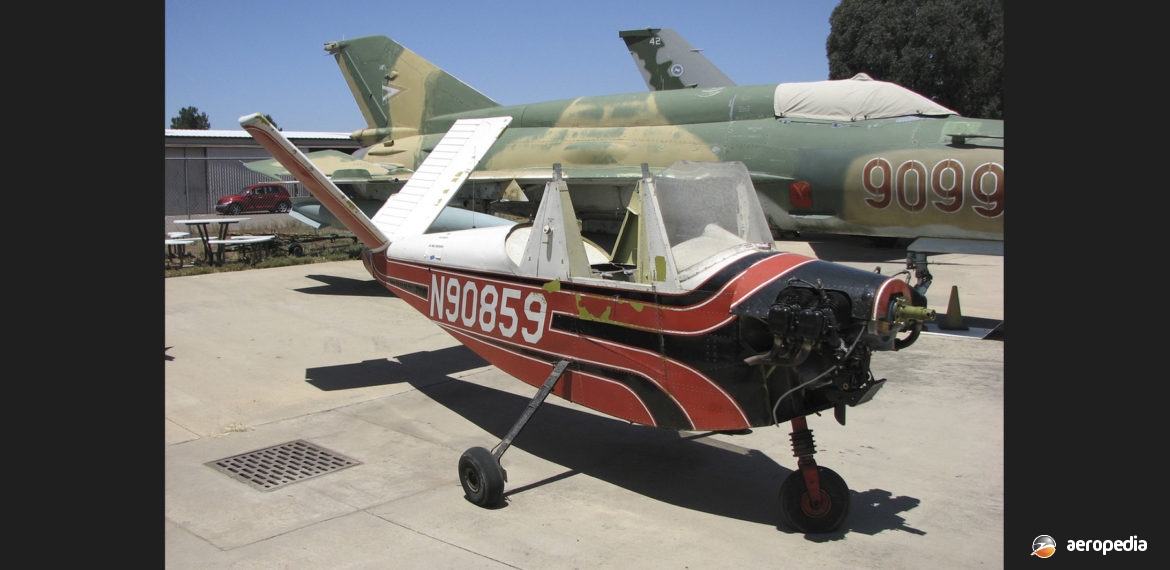Photograph:
Bee Aircraft Honey Bee at the San Diego Air & Space Museum, USA (Author’s collection)
Country of origin:
United States of America
Description:
Single-seat light sport monoplane
Power Plant:
One 48 kw (65 hp) Continental A-65 four-cylinder horizontally-opposed air-cooled engine
Specifications:
- Wingspan: 8.53 m (28 ft)
- Length: 5.48 m (18 ft)
- Height: 2.4 m (7 ft 10 in)
- Wing area: 8.91 m² (96 sq ft)
- Max speed: 219 km/h (136 mph)
- Cruising speed: 187 km/h (116 mph)
- Stalling speed: 80 km/h (50 mph)
- Rate of climb at sea level: 244 m/min (800 ft/min)
- Take-off and landing run: 244 m (800 ft)
- Service ceiling: 5,791 m (19,000 ft)
- Range: 370 km (230 miles)
- Fuel capacity: 32 litres (7 Imp gals)
- Baggage capacity: 11 kg (25 lb)
- Empty weight: 277 kg (610 lb)
- Wing loading: 9 lb/sq ft
- Loaded weight: 390 kg (860 lb)
History:
The Bee Aircraft Honey Bee was a single-seat all-metal light aircraft designed by William Chana and Kenneth Coward, engineers with Convair, formerly Consolidated Vultee, in San Diego, California, USA in the 1970s. The first example was flown for the first time on 12 July 1952. This aircraft survives, was donated by the American Experimental Aircraft Association to the San Diego Air & Space Museum, and is now on display.
The founders of Beecraft Associated Inc were responsible for a number of designs. The first was the Wee Bee, a monoplane claimed to be big enough to lift a man but small enough to be lifted by one. It was demonstrated in the United States and England. This aircraft was listed in the Guinness Book of World Records as the world’s lightest aircraft. It had a two-cylinder engine and a tricycle undercarriage, the pilot flying in a prone position on top of the fuselage.
This was followed by the Honey Bee, the first example of which was completed in 1952. It was a single-seater, had an enclosed cabin, a high cantilever monoplane wing and a V-tail. The designers then designed and built the Queen Bee, which seated four and was completed in 1960. Eventually the Wee Bee and Queen Bee were retired to the San Diego Aerospace Museum but these two prototypes were destroyed by a fire at the museum premises on 22 February 1978. However, the Honey Bee prototype was still operating at that time at Montgomery Field and in 2004 the Experimental Aircraft Association (EAA) donated it to the San Diego Air & Space Museum at Gillespie Field where it was to be restored.
Plans were made available by Bee Aviation of San Diego. The structure was simplified normal aircraft sheet metal with a cantilever wing of flanged aluminium alloy ribs riveted to the main spar, the whole being covered with light gauge aluminium skin. It had a VEE or butterfly tail of similar construction and the control surfaces were of pressed, fluted skins. The fuselage was of semi-monocoque structure, made of flanged aluminium frames and stringers, with metal skin. It had a tricycle undercarriage, a steerable nose leg and spring steel main legs. It could be fitted with a variety of engines but usually the 48 kw (65 hp) Continental was installed.
The Honey Bee was the first all-metal light aircraft design approved by the Australian Department of Civil Aviation for construction by amateur builders. At least one example was built in Australia. The first known to have been built in this region was constructed by students as Project Honey Bee at the Royal Melbourne Institute of Technology, VIC. Another was under construction in the mid 1970s by the Ultra-light Association, Victorian Division. It is known construction of a couple of others was commenced. If any were completed, they were operated under ultralight / RAA Regulations. Photographs of any of these have not yet come to light.

